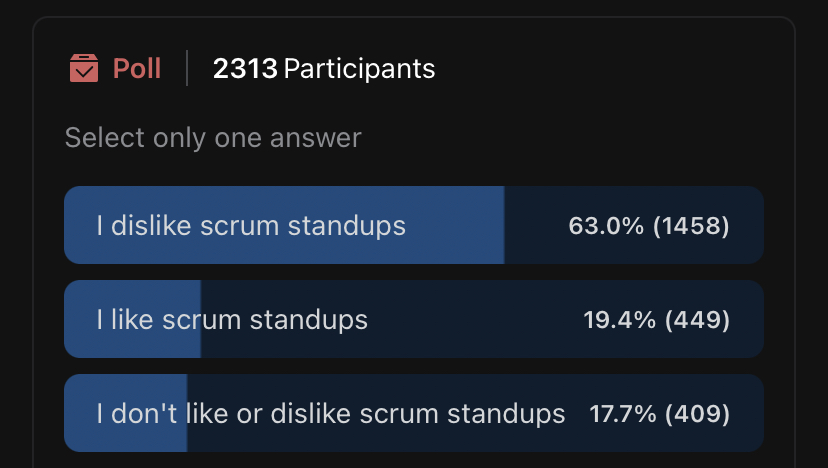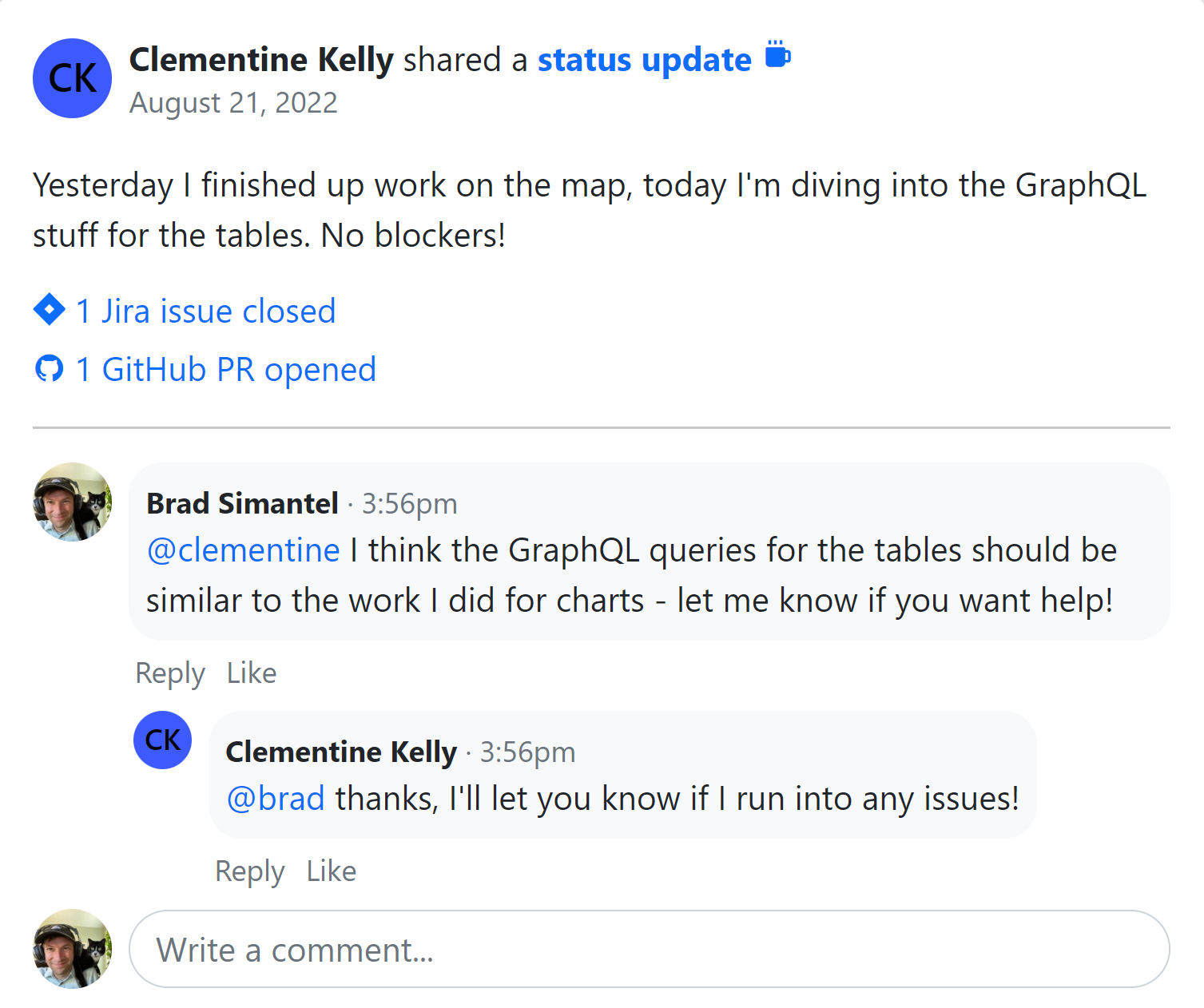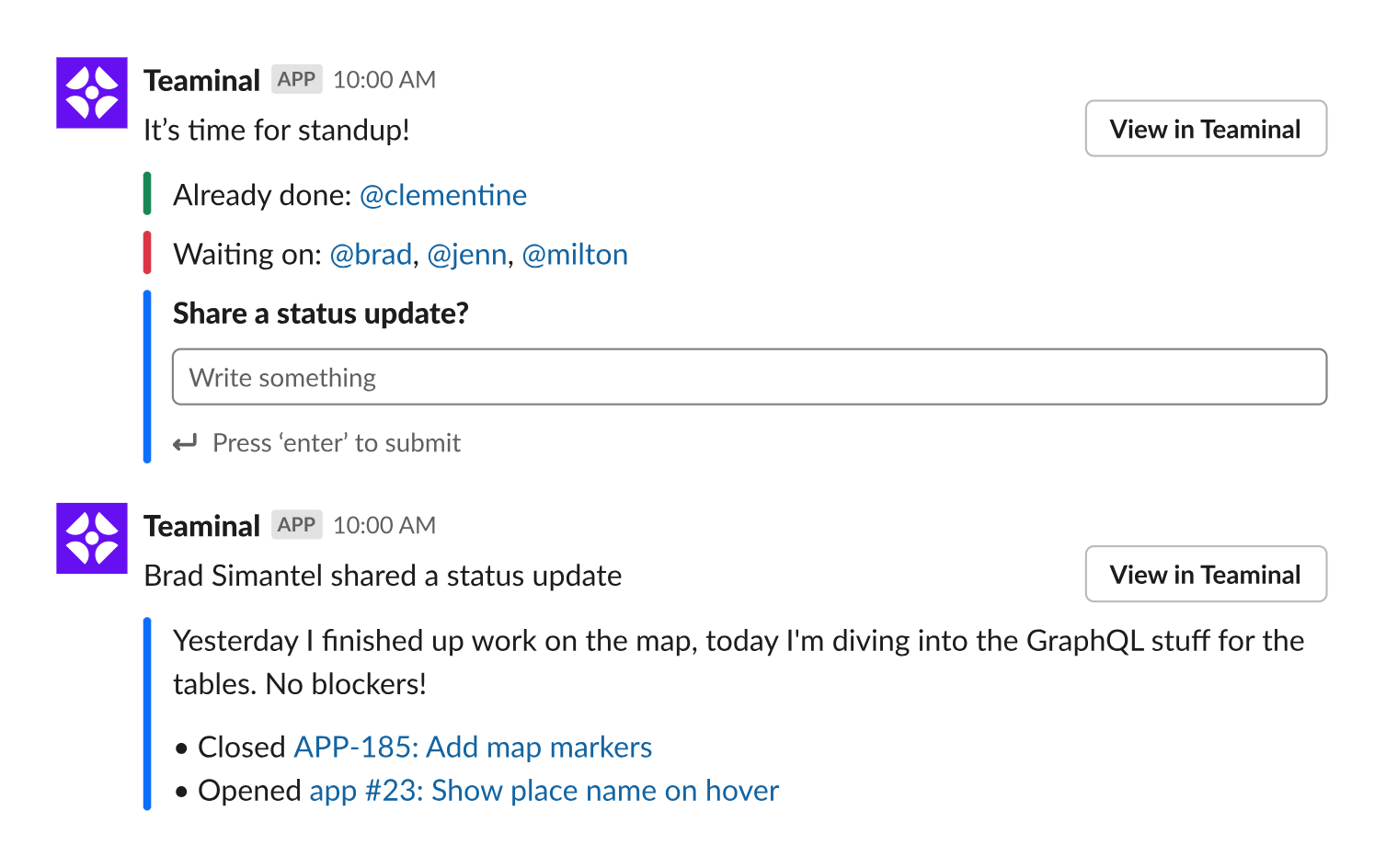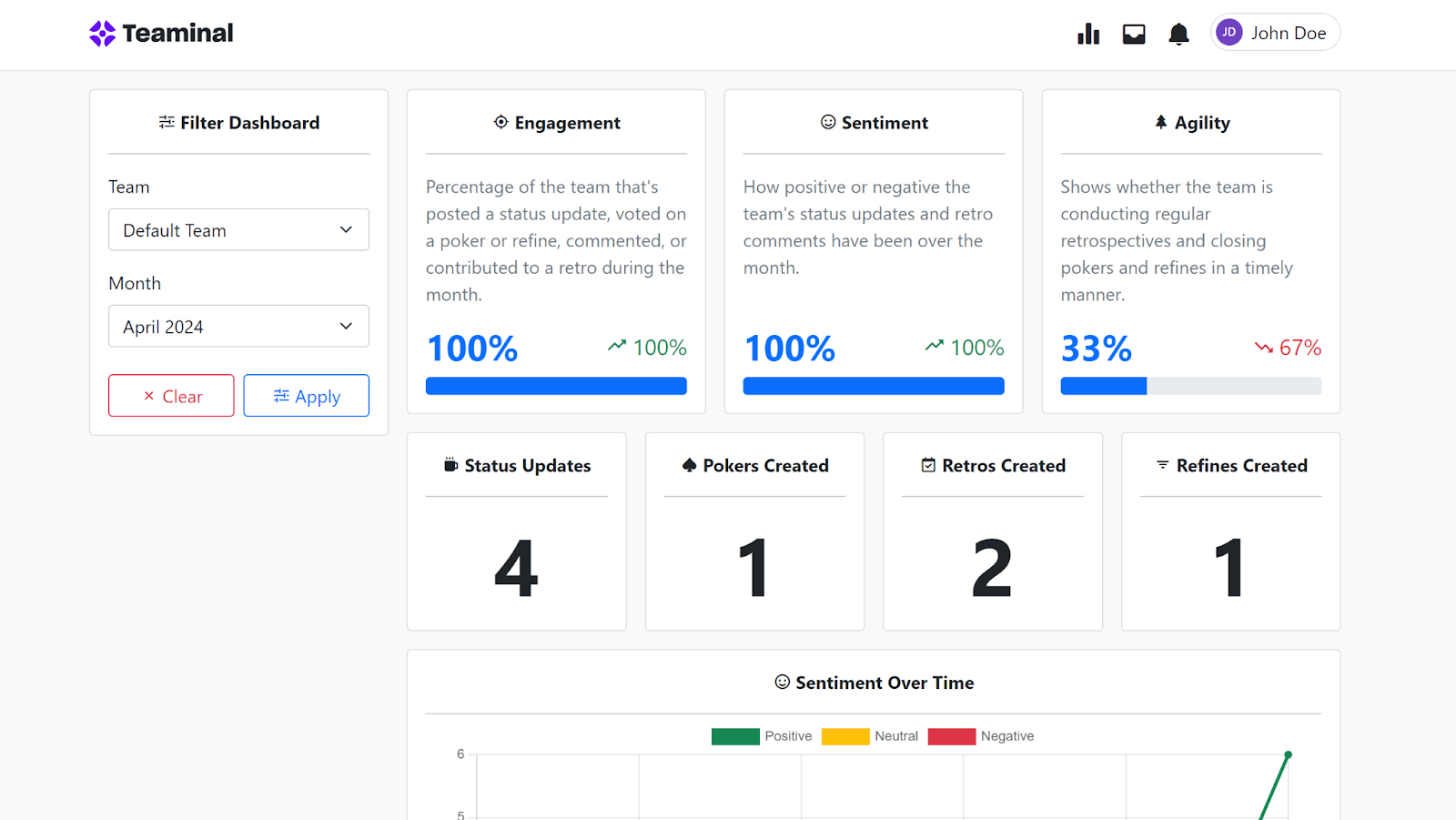Helpful Summary
- Overview: We introduce you to async standups explain the benefits, and give you a step-by-step process to implement them successfully
- Why you should listen to us: We’re trusted by Agile teams at leading companies like T-Mobile, Medium, and IKEA as a powerful tool for streamlining async ceremonies (including standup meetings).
- Why it matters: Async standups can save significant costs related to lost productivity during traditional standup meetings. You can also retain more of your employee’s productive time, benefit from easy scheduling, and enjoy better organization.
- Action points: To implement async standups using Teaminal, start by selecting our platform, inviting your team, and choosing necessary integrations. Then, establish a routine that includes daily or regular updates submitted at a specific time each day, ensuring that responses are reviewed and addressed timely.
- Further research: Standups aside, you can visit our blog to learn how we can help you implement other async agile ceremonies, from retros to backlog refinements.
Want to Learn How to Implement Agile Standups?
From our interactions with agile teams, we have good reasons to believe almost every employee secretly hates traditional standup meetings.
You might not believe us, but you know data doesn’t lie. In a survey of 2,300 developers conducted by Blind, 63% admitted that they genuinely dislike daily standups. And (in our opinion) it’s not hard to see why.

These meetings often make employees feel micromanaged. Sometimes, they drag longer than they should. And the absolute worst thing about traditional standups? They always seem to come when team members step into their productive headspace. Finding that groove again after the meeting can be a real challenge.
But the silver lining is that you can avoid all these issues by switching to async standups. In this article, we’ll explain what an async standup is and how you implement them in minutes with Teaminal.
Before we get into the article…
Why Listen to Us?
Teaminal was born from our founder’s firsthand experience with the challenges of traditional agile ceremonies. We’re passionate about making sure that remote teams have access to tools that let them reap the benefits of agile without the drawbacks.

Today, Agile teams at leading brands like T-Mobile, Medium, and IKEA use our platform to plan async agile ceremonies, including standups. The point? We have the expertise, experience, and feature set to help you successfully implement async standups.
What Is an Async Standup?
An async standup is just like a regular standup meeting.
Team members discuss yesterday’s accomplishments, today’s goals, and any blockers standing in their way. The difference? It takes place asynchronously—everyone contributes to the discussion on their own time, rather than during a set meeting window.
This can be done with:
- Slack
- Teams
- Loom
…but you’ll have the best results with a purpose-built async Agile meeting tool like Teaminal.

We send daily automated check-ins to team members who should participate in the standup via Slack. These check-ins typically include the regular standup prompts—accomplishments, goals, and blockers.
Then, when the team member logs in for the day, they can answer these questions at their own convenience. Discussions happen in comment threads, and we automatically pull in data about closed tickets and code changes via integrations.
The result? A seamless, organized, and painless standup process that can be completed in 5 minutes (or less).
Why Async Standups Should Be on Your Radar
Saves You Money
A Shopify study shows that a 30-minute meeting with three participants can cost companies anywhere from $700 to $1600 in lost productivity.
A typical 15-minute standup meeting means $800 down the drain. With daily standup meetings, that adds up to around $16,000 per month. That’s enough money to add another senior developer to your team. Mind you, this cost can still go up based on the number of employees in the meeting.
Async standups help minimize meeting times, so they keep these meeting-induced losses to a minimum.
Easy Scheduling
Coordinating a meeting across different time zones can often feel like an Olympic sport—doable, but difficult. Async standups eliminate this struggle since team members can contribute updates at their own convenience.
Improved Info Recall
Traditional standup meetings are fleeting, so it’s easy to forget the information shared. But with async standups, you’d have a central communication channel to document every update. This way, team members can easily reference past updates, ask clarifying questions, and ensure everyone has a clear picture of progress.
5 Proven Ways to Implement Async Standups
1. Decide on an Async Standup Platform
The first step to successfully run async standups is finding the right platform. You don’t have to look too far because that’s what we do here at Teaminal.
Let’s re-introduce ourselves.
Teaminal is an agile meeting tool created to help remote teams streamline ceremonies asynchronously. These include sprint retros, planning, backlog refinements, and, of course, standups.
Besides code repositories and project management tools, we integrate nicely with Slack. All you need to do is set up a recurring meeting in the Teaminal web app, install our Slack app, and we’ll handle the rest—reminding your team to provide updates and enriching their updates with data.
Here’s what it looks like.

Our free tier is a great way to test the waters and see if Teaminal is a good fit for your team, but it’s limited to 15 team members. So, if you manage a larger team, you can opt for our premium plan, which starts at just $6 per user per month.
2. Get Your Team Onboard
The success of any new process hinges on team buy-in. If you have traditional standup purists on your team, their resistance to change might affect your sync implementation. So, it’s up to you to take the time to bring them on board. Essentially, you want to explain the new system’s benefits to your team and make them see why it’s a good option.
After you’ve gotten them thinking async, invite them to Teaminal and set them up. It literally takes just a few minutes.
Then, take the time to outline clear expectations for how async standups will work in your team. This includes:
- Frequency: Decide how often updates will be submitted (daily, every other day, etc.).
- Standardized Format: Establish a clear structure for updates, such as “Yesterday’s Accomplishments,” “Today’s Priorities,” and “Roadblocks.” Providing a template can be helpful.
- Time Frame: Set a specific deadline for when updates should be submitted each day (e.g., by the end of the workday or by a specific morning hour).
3. Respond and Follow Up
One of the core strengths of traditional standup meetings is the opportunity for real-time interaction and problem-solving. While async standups offer flexibility, it’s important not to lose the value of engagement and follow-up.
So, don’t let your team members’ responses sit unanswered. Set aside time each day to actively review and respond to their updates. For example, you may offer assistance with any blockers they mention or acknowledge their achievements for the day.
Ideally, your response should come within a reasonable time frame (e.g., within the workday or by the next morning). This demonstrates that you value their input and encourages continued participation.
4. Find the Right Balance
It’s tempting to use asynchronous communication for all project conversations, but that’s not advisable. While it works well for most projects, there are situations where synchronous communication is necessary.
Here’s a rule of thumb: if the conversation requires real-time exchange of information or quick brainstorming, a synchronous approach might be more efficient.
Here are some instances where you may consider synchronous communication:
- Urgent issues or roadblocks
- Brainstorming sessions
- Quick technical clarifications
- Important decisions that need group input and discussion, which could make asynchronous threads too long and confusing,
- Team building and morale activities
- Onboarding new team members
- Performance reviews
- Team conflict resolution
5. Keep Track of Participation
After implementing async standups, don’t just leave the rest to luck; monitor participation closely.
Tracking participation can help you gauge how well your team adapts to the new format. High participation generally means they’re settling well.
But low participation, on the other hand, could mean lots of things—your employees might be confused about the entire thing or maybe just simply disengaged. You can conduct a mini-survey to determine the underlying issue and address it accordingly.
For example, if confusion is the issue, you could re-explain everything involved, making it easier for team members to contribute.
But how do you track participation? Simply go to your analytics dashboard on Teaminal. There, you’ll find the “engagement” metric. This shows your participation rate in real-time and whether it’s increasing or decreasing.
Here’s an example:

Here you can also keep tabs on sentiment and agility (how often you’re conducting retros and planning poker sessions, as well as the raw stats on the number of meetings you’ve held.
Ready to Start Thinking Async?
Async standups bring reliable solutions to the longstanding issues of traditional standups. They can save money, productivity, and time while promising better organization.
If you’re ready to start, this article provides a good starting point. Just implement the tips we provided and you’ll be good to go.
Remember, choosing the right async standup tool is crucial. And we’re confident that Teaminal is the best option out there, with competitive pricing and great features to match.
So, why wait? Get started for free today!




